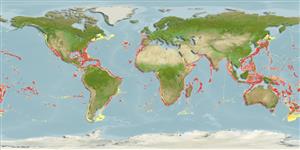Common names from other countries
>
Scombriformes (Mackerels) >
Gempylidae (Snake mackerels)
Etymology: Lepidocybium: Greek, lepis = scale + Greek, kybion, -ou = tunna (Ref. 45335).
Environment: milieu / climate zone / depth range / distribution range
ນິເວດວິທະຍາ
ສັດທະເລ ກ່ຽວກັບ (ຢູ່)ເທິງຊັ້ນພື້ນດິນໃນທະເລເປີດ; ປາທີ່ມີການເຄື່ອນຍ້າຍໃນສະເພາະມາະຫາສະມຸດ (Ref. 51243); ລະດັບຄວາມເລິກ 200 - 1100 m (Ref. 44037). Deep-water; 50°N - 56°S, 180°W - 180°E (Ref. 6181)
Tropical and temperate seas of the World, but probably not occurring in the northern Indian Ocean. Northwest Atlantic: Canada (Ref. 5951). Eastern Atlantic: known from 13°N off Guinea to Lobutu, Angola (Ref. 10816).
ຂະໜາດ / ນ້ຳໜັກ / Age
Maturity: Lm ? range ? - ? cm
Max length : 200 cm SL ຕົວຜູ້/ບໍ່ມີເພດ; (Ref. 6181); common length : 150 cm SL ຕົວຜູ້/ບໍ່ມີເພດ; (Ref. 6181); ນ້ຳໜັກສູງສຸດທີ່ເຄຍຈັດພີມມາ: 45.0 kg (Ref. 3403)
ຄີ (ໜາມ)ແຂງຢູ່ຫຼັງປາ (ທັງໝົດ) : 8 - 9; ຄີຫຼັງຂອງປາ (ຄີອ່ອນ) (ທັງໝົດ) : 16 - 18; ຄີ(ໜາມ) ແຂງຢູ່ຄີກົ້ນປາ
ກຸ່ມປາກະດູກແຂງ
ຄວາມຖີ່ຂອງກຸ່ມຖ່າຍທອດພັນ
ປາທີ່ມີການເຄື່ອນຍ້າຍຈາກທະເລໄປຫານ້ຳຈືດ ແລະນ້ຳຈືດຫາທະເລ
ປາທີ່ມີການເຄື່ອນຍ້າຍຈາກທະເລແລະໄປໄຂ່ຢູ່ນ້ຳຈືດ
ຄີກົ້ນຂອງປາ
ສັດທີ່ມີກະດູກສັນຫັຼງ
ການຖ່າຍທອດທາງກຳມະພັນຈາກພໍ່ແມ່ຫາລູກ: 1 - 2; ຄີກົ້ນຂອງປາ: 12 - 14; ສັດທີ່ມີກະດູກສັນຫຼັງ: 31. Body almost uniformly dark brown, becoming almost black with age. Pelvic fins well developed, with I spine and 5 soft rays (Ref. 9784). Prominent lateral keel on caudal peduncle, flanked by smaller accessory keels above and below (Ref. 26938).
Occurs mainly over the continental slope, down to 200 m and more (Ref. 6181). Migrates upward at night (Ref. 6181). Feeds on squid, crustaceans and a wide variety of fishes (Ref. 6181). Flesh oily and may have purgative properties (Ref. 9784). Sometimes caught by tuna long-liners (Ref. 26938). Marketed frozen and as fish cakes in Japan (Ref. 9302).
Life cycle and mating behavior
Maturities | ການສືບພັນ | Spawnings | Egg(s) | Fecundities | ຕົວອ່ອນ
Nakamura, I. and N.V. Parin, 1993. FAO Species Catalogue. Vol. 15. Snake mackerels and cutlassfishes of the world (families Gempylidae and Trichiuridae). An annotated and illustrated catalogue of the snake mackerels, snoeks, escolars, gemfishes, sackfishes, domine, oilfish, cutlassfishes,. scabbardfishes, hairtails, and frostfishes known to date. FAO Fish. Synop. 125(15):136 p. (Ref. 6181)
IUCN Red List Status (Ref. 130435)
CITES (Ref. 128078)
Not Evaluated
Threat to humans
Harmless
Human uses
ການປະມົງ: ທີ່ເປັນການຄ້າໜ້ອຍ
ເຄື່ອງມື
Special reports
Download XML
ແຫຼ່ງອີນເຕີເນັດ
Estimates based on models
Preferred temperature (Ref.
115969): 7 - 14.4, mean 9.9 (based on 642 cells).
Phylogenetic diversity index (Ref.
82804): PD
50 = 1.0000 [Uniqueness, from 0.5 = low to 2.0 = high].
Bayesian length-weight: a=0.01175 (0.00597 - 0.02312), b=2.98 (2.79 - 3.17), in cm Total Length, based on LWR estimates for this species & (Sub)family-body (Ref.
93245).
ຊັ້ນເຂດຮ້ອນ (Ref.
69278): 4.3 ±0.67 se; based on food items.
ຄວາມຢືດຢຸ່ນ (Ref.
120179): ຕຳ່, ປະຊາກອນຕຳ່ສຸດທີ່ໃຊ້ເວລາສອງເທົ່າ 4.5 - 14 ປີ (Assuming tm=4-5).
Fishing Vulnerability (Ref.
59153): Very high vulnerability (90 of 100).
Climate Vulnerability (Ref.
125649): Moderate vulnerability (39 of 100).
